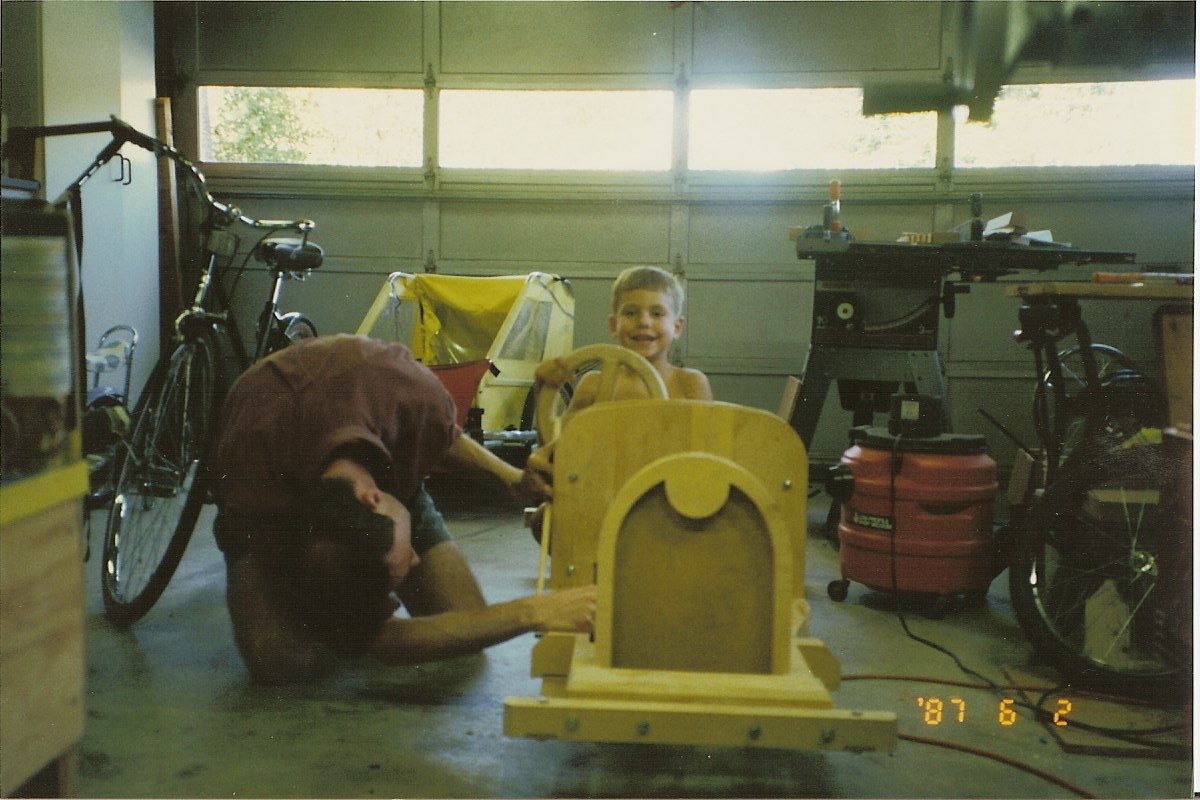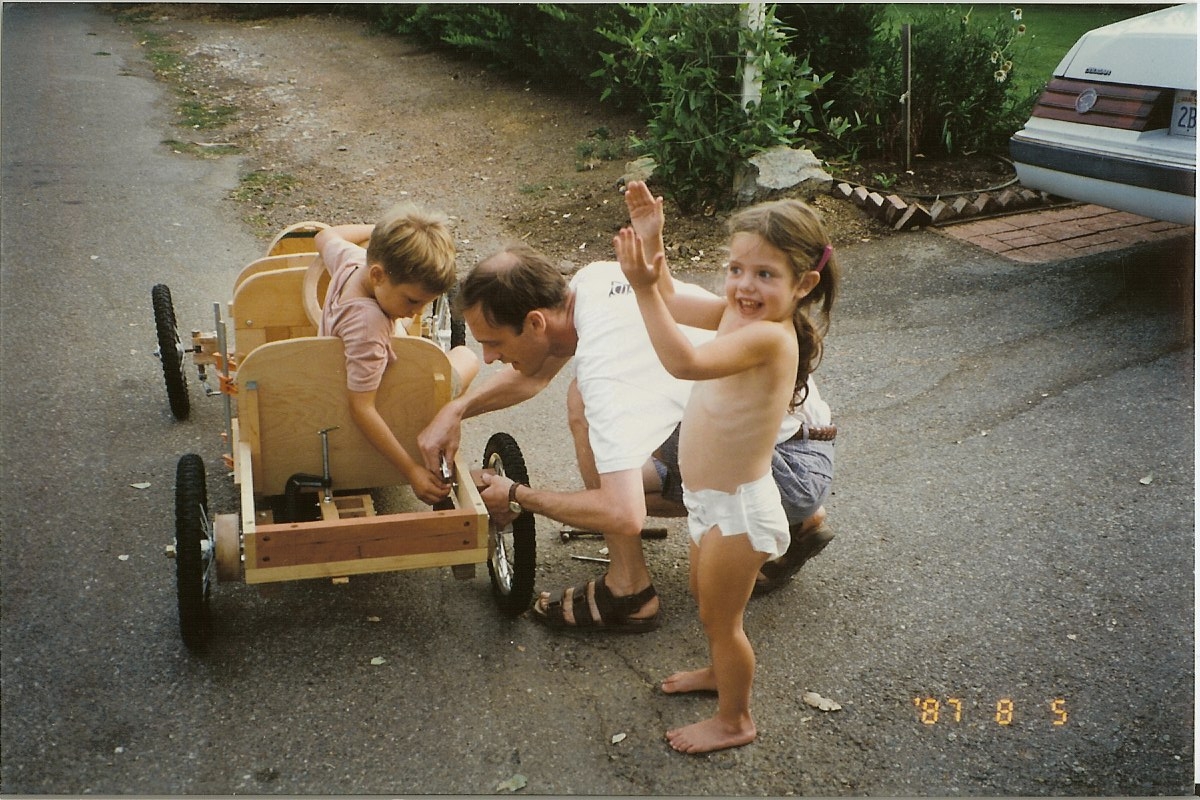Los Altos, December 2005
So you would like to know more about the Baby Bugatti?
As a start, you should read the story from the 1997 "Los Altos Town Crier".
 For
a long time I
was torn about
where to draw the line between commercial versus handmade components.
The steering wheel for instance caused many sleepless nights! Should I
go looking for a manufactured one, or how would I make one? I finally
settled on making one. It's construction is based on glue laminated
pieces of oak, which is cut into its final shape using my mill. Here's
a shot of Bjorn lending a hand while dad is trying to figure out how to
arrange the steering mechanism. Much of the construction was improvised
as work progressed.
For
a long time I
was torn about
where to draw the line between commercial versus handmade components.
The steering wheel for instance caused many sleepless nights! Should I
go looking for a manufactured one, or how would I make one? I finally
settled on making one. It's construction is based on glue laminated
pieces of oak, which is cut into its final shape using my mill. Here's
a shot of Bjorn lending a hand while dad is trying to figure out how to
arrange the steering mechanism. Much of the construction was improvised
as work progressed. Powering
the rear
wheels was another challenge. Should I go out and buy a commercial
drive train? How about brakes? I finally decided to use a 5/8" steel
rood as an axle on which I mounted a miter gear. The gear is
encapsulated in a custom designed oak box sporting a bearing on each
side. Here you can also see the two wooden drum brakes. More about that
later. One of the rear wheels is locked onto the axle with a steel key,
which the other is free wheeling. The wheels are held in place with a
lock nut/cotter pin. Finally, the rear drive train is attached to the
chassis through a pair of oak leaf springs. Hanna is cheering, as she's
waiting for her first ride.
Powering
the rear
wheels was another challenge. Should I go out and buy a commercial
drive train? How about brakes? I finally decided to use a 5/8" steel
rood as an axle on which I mounted a miter gear. The gear is
encapsulated in a custom designed oak box sporting a bearing on each
side. Here you can also see the two wooden drum brakes. More about that
later. One of the rear wheels is locked onto the axle with a steel key,
which the other is free wheeling. The wheels are held in place with a
lock nut/cotter pin. Finally, the rear drive train is attached to the
chassis through a pair of oak leaf springs. Hanna is cheering, as she's
waiting for her first ride. No
brakes and
driving under age! The maiden drive has past its muster while dad was
delivering the "push-power". Here you get an idea of the steering
mechanism and front suspension. All wheels have custom made aluminum
hubs. The front wheels rotate on a 1/2" steel rod through a pair of
ball bearings. The horizontal rod is welded to a 5/8" vertical steel
rod which is held in place with an upper and lower bushing embedded in
an oak bar. The bar keeps the front wheels aligned. Steering is done
through a worm gear box and a Pitman arm. I was truly amazed at how
well the Bugatti handled. This beast had potential.
No
brakes and
driving under age! The maiden drive has past its muster while dad was
delivering the "push-power". Here you get an idea of the steering
mechanism and front suspension. All wheels have custom made aluminum
hubs. The front wheels rotate on a 1/2" steel rod through a pair of
ball bearings. The horizontal rod is welded to a 5/8" vertical steel
rod which is held in place with an upper and lower bushing embedded in
an oak bar. The bar keeps the front wheels aligned. Steering is done
through a worm gear box and a Pitman arm. I was truly amazed at how
well the Bugatti handled. This beast had potential.
Now a few words about the brakes. I knew that whatever I designed, it had to be extremely easy and powerful. Rather than a foot pedal, I decided on a "brake stick" attached to a 1/2" steel rod. The stick is mounted on the right hand side, while the rod is mounted in a pair of bushings and traverses the width of the chassis. One lever for each rear wheel is attached to the rod, which in turn pulls a bicycle brake cable which is attached to a band circumnavigating the rear brake drums. As the brake stick is pulled, the band on each of the rear brake drums is pulled tight, thus proving the brake action. They work great! The kids can with little effort make those rear wheel stop bringing the Bugatti to a quick halt.
About a year later, I capitulated and bought a 1/3hp
The Bugatti has been on display at our local history museum of Los Altos, and is currently suspended under our garage ceiling waiting for the next generation...
- Mogens Lauritzen
